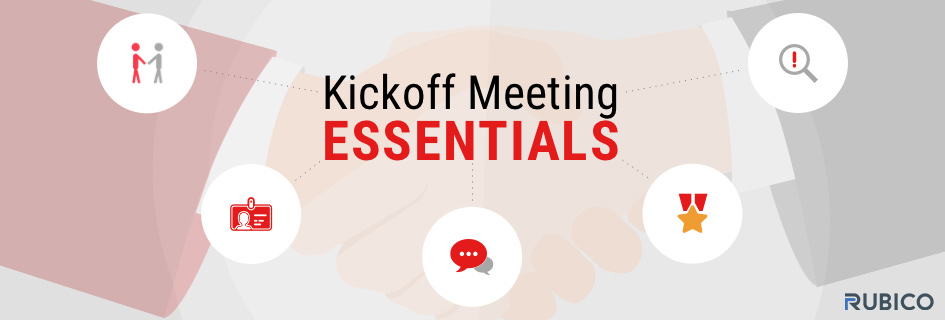Project Meeting Essentials

How to stage a project for success.
Are you wanting a successful, outsourced project? When working with a geographically-dispersed team, a successful project begins with a well-thought-out project startup meeting, or kickoff meeting. At Rubico we have 5 essential criteria that will make a routine meeting rewarding.
Build Relational Capital

There is nothing worse in a kickoff meeting than a strict agenda and no small talk. Business is about relationships and then getting projects accomplished. Without the former, the latter falls apart very quickly. In that first meeting of introductions, use video, or at least photos of yourself. Be sure that everyone present gets in on the dialogue.
At the beginning of the kickoff meeting, the Business Development (BD) team will need to explain operations to the client and, at the same time, communicate a high-level of trust in the delivery team. Reviewing the client’s history will clear up any assumptions they may have, based on past experiences. You can ask questions like:
- Do you work (or have you worked) with off-site contractors, vendors, or freelancers?
- Where were they located?
- If yes, how was that experience working with them?
- What challenges did you face?
Remember: Relationships come first, before a successful project can begin.
Define Roles

From the very start, you will want to know who, from the client end, is responsible for decision-making during the project. That individual will be known as the Product Owner (PO). Be sure the PO is accessible through phone, email, and any other communication method you use. The PO should know, very clearly, that he or she has the authority and responsibility to control the project.
Also, the PO should know what role each team member plays. A team will consist of many members doing their specific tasks, but the PO should also understand that communication always goes through the Project Coordinator (PC) also known as the Scrum Master. Does the PO have feedback regarding the design, layout, or technology considerations? If so, then he or she needs to contact the PC, who will communicate with the team members working on that specific aspect of the project.
So why do roles need to be clearly laid out? Two scenarios come to mind. When it isn’t clear who the PO is, decision-making becomes a messy business. Knowing who will ultimately say “yes” or “no” on a project, keeps the project moving. In another case, if the PO has a problem, rather than contacting an individual designer or coder and confusing the rest of the team, the PC can clarify with the entire team how to fix a problem.
Remember: Clearly-defined roles clarify communication.
Clear Collaboration

Take a look at all the communication and document-sharing tools available. Which one does your team use? What one does each of your clients use? Chances are you may not be using the same tools. Clarify with your client what project management system works best for them. They may have something already set in place, or they may ask for your recommendations. Have that conversation. In the end, the client should choose which collaboration/management tool should be used and everyone else will adapt accordingly.
Understand their corporate culture and communication style. Introduce them to your company’s way of communicating. There may be certain phrases that you use among team members. Teach these to your client, and ask them to share how they communicate with their employees. This will bring them into your circle of communication, while also including their thoughts and communication style as well.
Remember: Without clear communication, there’s no collaboration.
Specify Success Criteria

How does your client define success for the project? This is important so your team can work toward that goal (and exceed those expectations, if possible). Review with your client: What is in scope for this project? What is out of scope?
What makes the PO satisfied when the project is complete? Maybe having the project launched by a certain date at a certain conference is the highest priority. It is not always just building a user-friendly product.
Remember: A well-defined scope and goal keep a project on track.
Identify Risks

Always ask yourself: What could go wrong in this project?
Then talk to your client about your concerns. Assure them that the goal of discussing any potential challenges is to know how to correct them if they occur. This builds trust with your client and prepares your team for action when it is needed.
Remember: Challenges will come. Don’t run away, but face them with your client.
Conclusion
Don’t leap into a project without taking the time to have a successful project kickoff meeting using these 5 essential points. At Rubico we believe building trust and clear communication makes for a rewarding project from start to finish. Do you have a project needing extra resources? Contact us today at solutions@RubicoTech.com.









